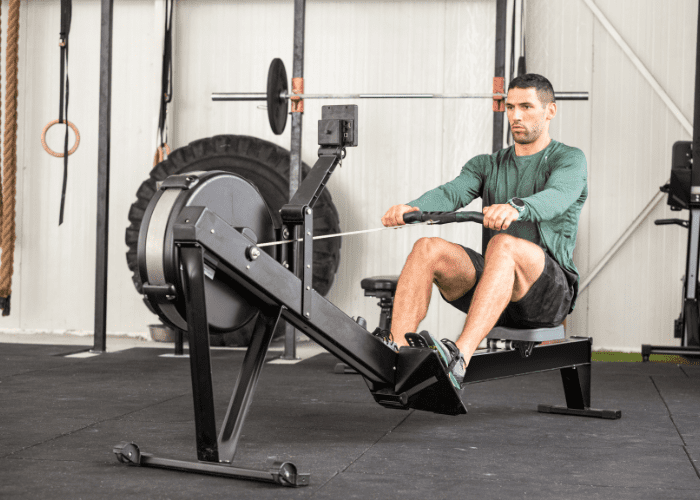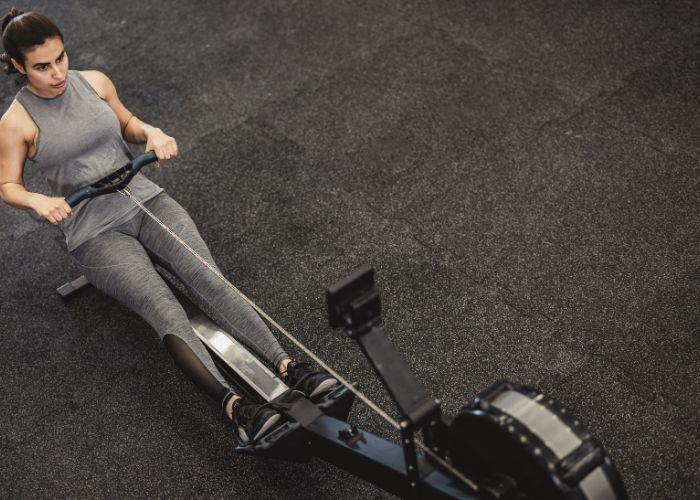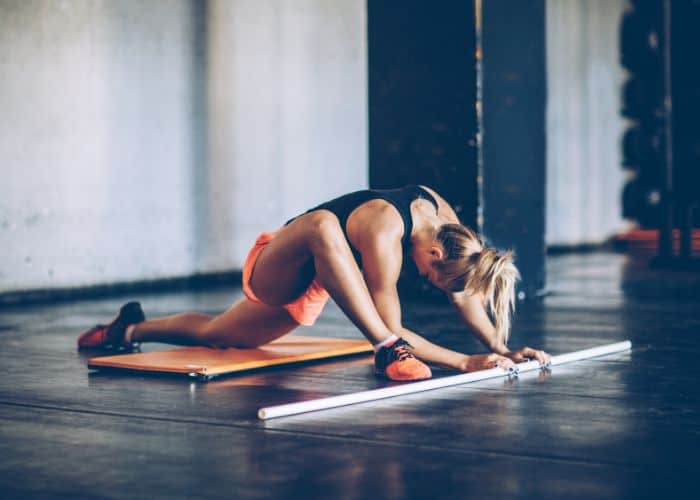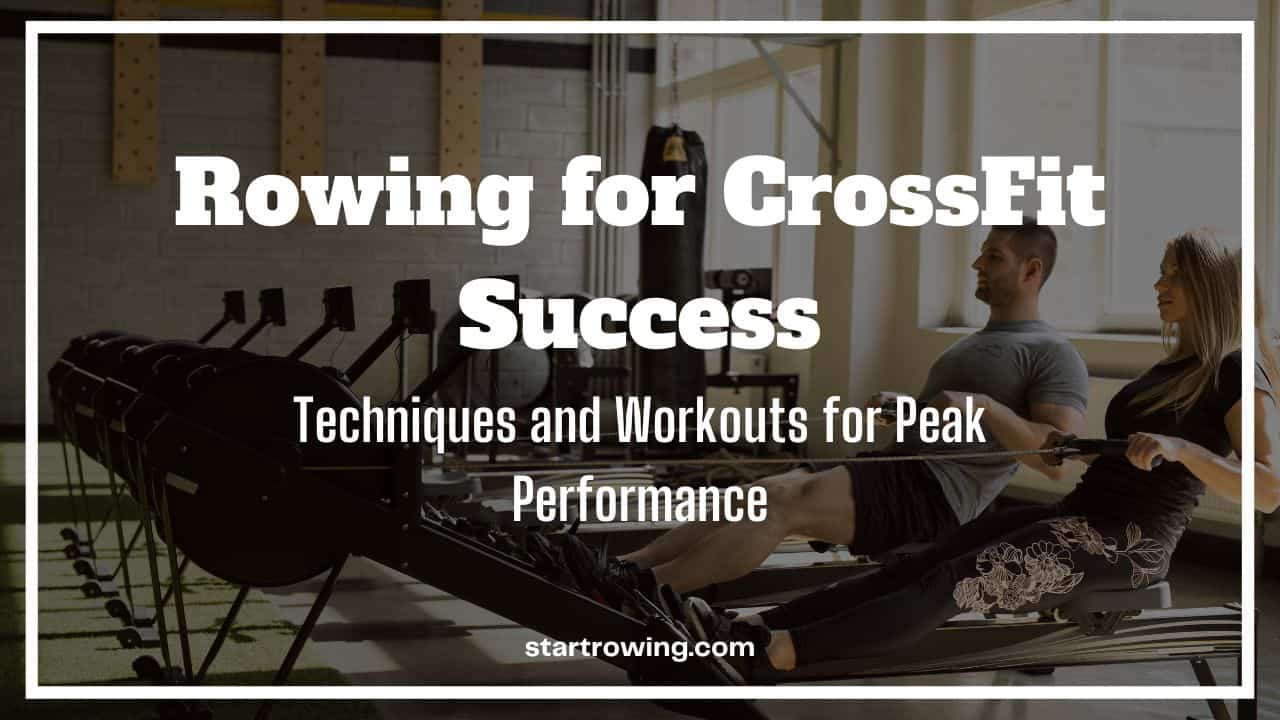Are you ready to supercharge your CrossFit game? Discover the ultimate secret weapon—rowing! As experts in the field, we’ll guide you on this exhilarating journey, providing you with insider knowledge to elevate your performance.
Unlock the benefits of rowing and pacing while optimizing every aspect of your workout. Dive in, unleash your potential, and watch as your fitness goals become reality. Don’t wait another moment; it’s time to row your way to success!
Table of Contents
Why CrossFit Uses Rowing Machines
Bridging the gap between strength and endurance, rowing machines have become a staple in CrossFit training, offering a multitude of benefits to athletes.
The Many Benefits of Rowing in CrossFit
Rowing is a fantastic addition to CrossFit workouts due to its low-impact nature, full-body engagement, and cardiovascular benefits.
It’s an efficient way to improve endurance, strength, and power. Rowing machines, such as the Concept2 rower are often used in CrossFit workouts and competitions.
Rowing as a Versatile Workout Component
In CrossFit, rowing is often paired with other movements like burpees, squats, or kettlebell swings, creating challenging and varied workouts that test different aspects of fitness.
It can also be used as a standalone workout, such as a 500m or 2000m time trial, to measure and improve endurance, power, and speed.
Rowing in CrossFit Games Events
Rowing frequently features in CrossFit Games events like the Marathon Row (42,195m), the Triple 3 (3000m row, 300 double-unders, 3-mile run), or the Row Sprint (500m row for time).
Combining rowing with other machines like the SkiErg or Assault Bike challenges different muscle groups and simulates different modalities.
Rowing’s Impact on CrossFit Performance
Statistics show that rowing engages 86% of the muscles in the body, compared to 44% for cycling and 35% for running. This means that rowing can improve overall strength, endurance, and coordination for CrossFit movements that require multiple muscle groups to work together.
Rowing can also improve aerobic capacity, anaerobic power, and VO2 max. A study by Penichet-Tomas et al. (2021) found that rowers had higher values of maximal oxygen uptake (VO2 max), maximal aerobic power (MAP), and maximal anaerobic power (MAPa) than non-rowers.
These variables are crucial for CrossFit performance, as they reflect the ability to sustain high-intensity efforts for longer periods.
Rowing can also improve body composition and reduce body fat percentage. A study by Shin et al. (2015) found that an eight-week indoor rowing program resulted in significant reductions in body mass, body fat percentage, and waist circumference in overweight and obese adults.
Testimonials on Rowing and CrossFit
Many CrossFit enthusiasts have found success and enjoyment in incorporating rowing into their workouts. Here are some personal experiences from the CrossFit community:
- “I used it on and off a little but toward the end of 2013, I decided I would row a 5k every day in 2014. The goal has escalated to two million meters by the end of the year. I have fallen in love with rowing, have become stronger and more efficient, and have become a CrossFit rowing instructor.” —Linda M., Concept2 testimonial
- “Rowing has helped me tremendously with my endurance during WODs. It has also helped me develop a better sense of pacing and breathing. I enjoy rowing because it challenges me both physically and mentally.” —John D., WODprep testimonial
- “Rowing is one of my favorite exercises in CrossFit because it works every muscle in my body and makes me sweat like crazy. It also helps me improve my technique and power output on other movements like thrusters, wall balls, and burpees.” —Sara L., CrossFit Journal testimonial
How to Use a Rowing Machine Properly

Proper rowing technique can prevent injuries, reduce fatigue, and increase efficiency. By mastering the correct form, you’ll be able to work harder, achieve better results, and enjoy your rowing workouts more, whether you’re a seasoned CrossFit athlete or just starting on your fitness journey.
Debunking Rowing Myths
There are a few common misconceptions about rowing that need to be addressed:
- Higher damper setting is better: A higher damper setting doesn’t necessarily mean a better workout. It just means more resistance, which can be too challenging for some and may lead to poor form or injury. The key is to find the right setting for your fitness level and goals.
- One size fits all: Rowing machines can be adjusted to accommodate different body sizes and preferences. Ensure that your rower is set up correctly for your body to prevent discomfort and maximize efficiency.
- Poor technique is acceptable: Poor rowing technique can lead to injuries and reduced efficiency. It’s essential to learn and practice proper form to avoid common pitfalls and get the most out of your rowing workout.
Understanding the Rowing Machine Components
Before diving into the rowing technique, it’s essential to familiarize yourself with the basic components and features of a rowing machine. These include:
- The monitor: Displays important workout data, such as time, distance, and pace.
- The damper: Adjusts the air resistance, which determines the difficulty of your workout.
- The foot straps: Help secure your feet to the footplates and ensure proper positioning.
- The handle: The part you hold onto while performing the rowing stroke.
The Four Phases of the Rowing Stroke
The rowing stroke can be broken down into four distinct phases: catch, drive, finish, and recovery. Here are some tips and cues on how to execute each phase with proper form and technique:
- The catch:
- Sit with your shins vertical and your feet flat on the footplates.
- Grab the handle with a relaxed grip and straight wrists.
- Lean your torso forward from your hips.
- The drive:
- Initiate the drive by pressing hard with your legs. Swing your torso back from your hips.
- Pull the handle to your lower chest with your arms.
- The finish:
- Keep your legs straight and flat on the footplates.
- Keep your elbows bent and relaxed.
- Keep your torso leaning back from your hips.
- The recovery:
- Extend your arms before moving anything else.
- Lean forward from your hips before bending your knees.
- Bend your knees once the handle clears them.
By practicing and perfecting these four phases, you’ll be able to row with proper form and technique, reducing the risk of injury and maximizing the effectiveness of your workout.
How to Improve Rowing Technique and Times
Improving your rowing technique starts by addressing common mistakes, such as overreaching, rounding the back, pulling too hard, or rushing the slide.
Being aware of these errors and making adjustments can lead to better rowing performance.
Drills and Exercises to Enhance Rowing Skills
Practicing specific drills and exercises can help improve aspects of rowing, such as leg drive, arm pull, or rhythm.
- Leg drive drills:
- Legs-only rowing: Focus on using your legs as the main source of power, keeping your arms straight and torso leaning forward throughout the stroke.
- Legs and back-only rowing: Coordinate your leg drive with your hip hinge, keeping your arms straight and relaxed.
- Legs-only rowing with pauses: Pause at different points of the stroke to improve balance, timing, and control of the leg drive.
- Arm pull drills:
- Arms-only rowing: Focus on using your arms as the final source of power, keeping your legs straight and torso leaning back throughout the stroke.
- Arms and body-only rowing: Coordinate your arm pull with your hip hinge, keeping your legs straight and stable.
- Arms-only rowing with pauses: Pause at different points of the stroke to improve balance, timing, and control of the arm pull.
- Rhythm drills:
- Rate changes: Alternate between lower and higher stroke rates to adjust your power output and acceleration.
- Counting your rhythm: Count the duration of each phase of the stroke to establish a consistent ratio between work and rest phases.
- Blades on the water: Rest blades on the water surface during recovery to relax and reset your reference points and patterns for each stroke phase.
Measuring and Monitoring Rowing Performance
Track your rowing performance using metrics such as:
- Strokes per minute (SPM)
- Split time (500m pace)
- Watts (power output)
- Calories (energy expenditure)
These metrics can help you gauge your progress and make adjustments to your training plan.
Setting Realistic Rowing Goals and Tracking Progress
To improve your rowing technique and times, set achievable goals and track your progress over time. Consider the following tips:
- Break down long-term goals into smaller, short-term objectives
- Use rowing metrics to monitor your progress and make adjustments as needed
- Celebrate your achievements and learn from your setbacks
- Stay consistent and committed to your training plan
Rowing and Pacing for CrossFit

Understanding Pacing in CrossFit Rowing Workouts
Pacing refers to managing your rowing speed and intensity to maintain consistent performance and efficiency throughout a workout.
In CrossFit workouts involving rowing, pacing is crucial for the following reasons:
- Avoiding fatigue, burnout, or injury
- Achieving optimal results
- Finding the right balance between speed and intensity
- Adjusting to different factors
- Synchronizing with others in team workouts
Factors Affecting Pacing in Rowing Workouts
Several factors can influence pacing during rowing workouts:
- Type and duration of the workout: Different workouts require unique pacing strategies, depending on their goal, intensity, and time domain. Determine the appropriate pace for a given workout by considering its specific demands and your personal fitness level.
- Damper setting and drag factor: These factors affect the resistance and feel of the rower. Choose the optimal damper setting and drag factor for your workout by taking into account your strength, endurance, and rowing technique.
- Stroke rate and rhythm: The stroke rate and rhythm impact the speed and intensity of your rowing. Find your optimal stroke rate and rhythm by experimenting with various combinations and observing their effects on your performance and fatigue levels.
Tips and Drills to Improve Pacing
To enhance pacing during rowing workouts, consider the following tips and drills:
- Find your optimal pace: Use methods or tools to measure your pace and monitor your progress. Adjust your pace based on feedback from your body, monitor, or coach.
- Adjust your pace for different workouts: Practice different pacing strategies for various rowing workouts. Incorporate rate changes, counting your rhythm, or blades on the water drills to refine your ability to adjust your pace.
- Synchronize your pace with others: In team workouts, synchronizing your pace with others can lead to improved performance and camaraderie. Use visual or auditory cues to align your pace with your teammates.
Sample Rowing Workouts for CrossFit
Here are some unique rowing workout examples that can be incorporated into your CrossFit routine or done as standalone sessions.
Remember to adjust the duration, intensity, rest periods, and scaling options for each workout to suit your fitness level and goals.
These workouts are designed to challenge various aspects of your fitness, such as power, endurance, and pacing:
Rowing Power Intervals:
- Row 250 m at maximum effort
- Rest for 90 seconds
- Perform 5 rounds
This workout focuses on building explosive power and speed, with ample rest between intervals to maintain intensity.
Row and Slam:
- Row 300 m
- Perform 20 slam ball slams
- Rest for 1 minute
- Perform 4 rounds
This workout combines rowing with a functional, full-body movement to challenge your cardiovascular system and muscular endurance.
Distance Rowing Challenge:
- Row 5000 m at a steady pace
- Try to maintain a consistent split time throughout
This workout tests your aerobic capacity, mental endurance, and pacing skills during a longer row.
Rowing and Bodyweight Circuit:
- Row 500 m
- Perform 20 air squats
- Row 400 m
- Perform 15 push-ups
- Row 300 m
- Perform 10 pull-ups
- For time
This mixed modality workout challenges your cardiovascular fitness and muscular endurance while incorporating bodyweight movements.
Descending Row Ladder:
- Row 1000 m
- Rest for 2 minutes
- Row 750 m
- Rest for 1.5 minutes
- Row 500 m
- Rest for 1 minute
- Row 250 m
- For time
This workout tests your ability to maintain intensity while decreasing the rowing distance and rest periods.
How to Warm Up and Cool Down for Rowing
Warming up and cooling down are crucial components of any workout, including rowing. They help prevent injury, improve performance, and enhance recovery.
This section provides unique examples of dynamic stretches, mobility exercises, and activation drills for warming up, as well as static stretches, foam rolling, and breathing exercises for cooling down.
Warm-Up Exercises for Rowing

Dynamic Stretches:
- Shoulder Rolls: Stand with your feet shoulder-width apart and gently roll your shoulders forward and backward. Perform 10-15 rolls in each direction.
- Ankle Circles: Lift one foot off the ground and perform circles with your ankle, clockwise and counterclockwise. Do 10-15 circles in each direction for both ankles.
- High Knees: Stand with your feet hip-width apart and march in place, lifting your knees as high as possible. Perform this for 30 seconds.
Mobility Exercises:
- Spiderman Stretch: Start in a push-up position. Bring your right foot up to the outside of your right hand, keeping your hips low. Hold for a few seconds, then return to the starting position. Repeat on the left side. Perform 8-10 reps per side.
- Cat-Cow: Start on your hands and knees. Round your back upward (like a cat) and hold for a few seconds. Then, arch your back, lifting your chest and tailbone (like a cow). Hold for a few seconds. Repeat for 10-12 reps.
- Lunge with a Twist: Step forward into a lunge position with your right foot. Twist your torso to the right, reaching your left hand toward your right foot. Return to the starting position and repeat on the other side. Perform 8-10 reps per side.
Activation Drills:
- Single-Leg Deadlifts: Stand on one leg, with a slight bend in the knee. Hinge forward at the hips, extending your free leg behind you while keeping your back straight. Return to the starting position and repeat for 10-12 reps before switching to the other leg.
- Clamshells: Lie on your side with your legs bent at 90 degrees and your feet together. Keeping your feet touching, lift your top knee as high as possible without moving your hips. Lower your knee back down slowly. Perform 12-15 reps on each side.
- Bird Dogs: Start on your hands and knees. Extend your right arm and left leg simultaneously, keeping your back straight and core engaged. Hold for a few seconds, then return to the starting position. Repeat with the left arm and right leg. Perform 10-12 reps per side.
Cool-Down Exercises for Rowing
Static Stretches:
- Seated Forward Bend: Sit on the floor with your legs extended in front of you. Reach forward with your hands toward your feet, keeping your back straight and knees slightly bent. Hold for 15-30 seconds.
- Calf Stretch: Stand facing a wall with your hands on the wall at shoulder height. Place one foot behind you, keeping your heel on the ground and toes pointing forward. Lean into the wall until you feel a stretch in the calf of your back leg. Hold for 15-30 seconds, then switch legs.
- Pectoral Stretch: Stand in a doorway with your forearm resting on the doorframe at a 90-degree angle. Lean forward slightly until you feel a stretch in your chest and shoulder. Hold for 15-30 seconds, then switch arms.
Foam Rolling:
- Hamstrings: Sit on the floor with your legs straight and a foam roller under your hamstrings. Lift your hips off the ground and roll back and forth from your glutes to your knees, pausing on any tender spots.
- Lats: Lie on your side with a foam roller under your armpit. Roll back and forth from your armpit to the bottom of your ribcage, pausing on any tender spots.
- Lower Back: Sit on the floor with your knees bent and feet flat. Place a foam roller behind your lower back and lean back onto it. Support your head with your hands and gently roll up and down your lower back, pausing on any tender spots.
Breathing Exercises:
- 4-7-8 Breathing: Sit or lie down in a comfortable position. Inhale through your nose for four counts, hold your breath for seven counts, and exhale through your mouth for eight counts. Repeat this cycle for several minutes.
- Three-Part Breath: Sit or lie down in a comfortable position. Inhale deeply, filling your abdomen, then your ribcage, and finally your chest. Exhale in reverse order, emptying your chest, ribcage, and abdomen. Repeat for several minutes.
- Belly Breathing: Sit or lie down in a comfortable position with one hand on your chest and the other on your abdomen. Inhale deeply through your nose, feeling your abdomen rise more than your chest. Exhale through your mouth, feeling your abdomen fall more than your chest. Repeat for several minutes.
Before You Go…
Now that you have gained valuable insights on rowing for CrossFit, as well as warm-up and cool-down techniques, it’s time to put this knowledge into action. Remember, consistent practice is key to improving your rowing performance and overall fitness. Whether you’re a beginner or an experienced athlete, these tips and workouts will help you level up your rowing game.
But don’t stop here! We encourage you to keep exploring our site for more valuable resources, articles, and workout routines. Our goal is to keep you informed, inspired, and engaged in your fitness journey. We regularly update our content with the latest trends, research, and expert advice, so be sure to check back often.
Before you go, we would love to hear your thoughts on this article and any personal experiences you’ve had with rowing in CrossFit. Feel free to leave a comment or reach out to us with any questions or feedback. Your input helps us create better content that caters to your needs and interests.
Keep rowing, keep improving, and stay engaged with us on your fitness journey!
Related Articles
- 30-Day Rowing Machine Program: Beginner
- CrossFit Athletes Shares Their Pre-Rowing Workout Routine
- Best CrossFit Rowing Machines
FAQs
What are the main benefits of incorporating rowing into my CrossFit routine?
Rowing offers numerous advantages, including improved cardiovascular endurance, full-body muscular engagement, increased calorie burn, and enhanced overall fitness performance.
How can I determine the appropriate pacing for my rowing workouts?
To find your optimal pacing, consider factors such as workout type, duration, damper setting, drag factor, stroke rate, and rhythm. Monitor your progress using feedback from your body, rowing monitor, or coach, and adjust your pace accordingly.
What should I focus on when warming up and cooling down for rowing sessions?
For warm-ups, prioritize dynamic stretches, mobility exercises, and activation drills. During cool-downs, emphasize static stretches, foam rolling, and breathing exercises to promote recovery and relaxation.
Can you recommend some sample rowing workouts for CrossFit?
Sure! Try these workouts:
– Rowing intervals: 8 x 300m, 1 min rest between intervals
– Row and bodyweight circuit: 3 rounds – 500m row, 15 push-ups, 15 air squats, 15 sit-ups
– Rowing pyramid: 200m, 400m, 600m, 800m, 1000m, 800m, 600m, 400m, 200m; rest equal to the time it took to complete the previous interval
How can I synchronize my pace with others during team rowing workouts?
To sync your pace, use visual cues such as watching the rower in front of you and match their rhythm, or auditory cues like following a set stroke rate provided by a coach or a metronome. Communication and practice are also key to synchronizing with others.


